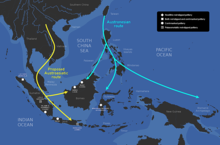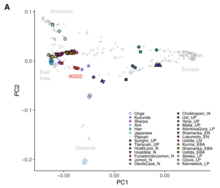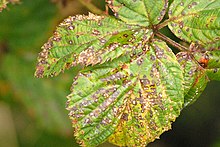동남아시아의 민족
Peopling of Southeast Asia동남아시아는 해부학적으로 현생인류에 의해 아마 7만년 [1]전에 처음으로 도달했습니다.해부학적으로 현대 인류는 7만년 전에서 5만년 [2][3]전까지 뚜렷한 동아시아 계층이 형성된 이후 남방분지의 이주 과정에서 동남아시아에 두 번 도달한 것으로 추정됩니다.
고고학적 발견
아시아에서는 중국(125-100 ka), 필리핀(58-24 ka), 말레이시아(40 ka), 스리랑카(36 [4]ka)에서 가장 최근의 고대 인류 화석이 발견되었습니다.이 유적지들에서 나온 유물들은 부분적인 골격, 두개골, 깊은 두개골, 그리고 다른 관련된 골격들을 포함하고 있는데, 이것은 현대 인류가 서양 이론보다 [5]일찍 아시아로 이주했다는 것을 보여줍니다.
2007년, Sangiran에서 발견된 두 개의 몸뼈에 있는 잘린 자국을 분석한 결과, 조개껍질 도구에 의해 150만년에서 160만년 전에 만들어진 것으로 나타났습니다.이것은 오늘날 인도네시아에 초기 인류가 존재했다는 것을 보여주는 가장 오래된 증거일 수도 있고,[6] 세계에서 조개 도구를 사용했다는 가장 오래된 증거입니다.
2009년, 고고학자들은 라오스 본토의 탐파링(Tam Pa Ling)에서 현대 인류의 두개골 일부와 치아 일부를 발견했는데, 이는 플라이스토세 [5]후기 동안 해부학적으로 현대 인류의 이주와 진화에 대한 이해를 조명한 것입니다.그 장소는 현대 라오스의 수도인 비엔티안에서 북쪽으로 약 170마일 떨어진 후아판 주에 위치하고 있습니다.이 유적지 내에서는 사람의 유골만 발견되었고, 사람이 점유한 흔적이나 다른 유물은 발견되지 않았습니다.숯의 방사성 탄소 연대 측정 및 퇴적물 연대 측정 분석을 통해 현재까지 유해가 최소 c. 56.5 ka인 반면 동위원소 비율 측정을 통해 분석된 유해의 치과 인공물은 c. 63.6 [5]ka임을 나타냅니다.두개골과 유골의 치열을 분석한 결과 동남아시아의 초기 근대 인류의 유골임을 알 수 있습니다.이 연대는 말레이시아의 니아 동굴에서 발견된 화석보다 더 오래된 것으로 동남아시아의 인류 진화에 대한 또 다른 설명을 제공합니다.
라오스에서 발견된 것 외에도, 동남아시아 본토 전역에서 발견된 다수의 인간 유해와 관련 유물들이 있는데, 이는 지역 후기 플라이스토세 개발의 새로운 아이디어를 암시하기도 합니다.태국과 베트남에서 발견된 더 많은 치아와 어금니 (Tham Wihan Naki, Tham Wihan Naki, 태국;Tham Kuyean, Vietnam 등)은 H. Erctus와 H. sapiens [7]사이의 전이를 나타냅니다.사실, 이 유골들은 태국의 [7]차이야품 지방에 있는 위한 나킨의 치아와 같이 H. erectus와 H. sapiens 사이에 교배 가능성을 나타낼 수도 있습니다.
마이그레이션
동남아시아의 가장 초기의 현대 인류 거주자들은 적어도 기원전 40,000년경에 그 지역에 도착한 수렵, 채집인들이었습니다.이러한 초기 거주자들의 동시대 잔존 집단(예: 말레이시아의 세망족 또는 필리핀의 아에타스족)은 보통 "네그리토"[8]라는 표지 용어로 포함됩니다.초기 정착민들은 월리스 선을 건너기에 충분한 해양 기술을 가지고 있었고, 아마도 사훌의 c.첫 번째 정착지와 비슷한 시기에 (45,000 BP/49,000 – 43,000 [9]: 50 BP).
신석기 시대는 오스트로아시아어족과 오스트로네시아어족 [8][10]화자들에 의해 중국 남부에서 본토와 섬 동남아시아로 여러 차례 이주한 것이 특징입니다.

신석기 시대에 오스트로아시아인들은 육로를 통해 인도차이나에 거주했습니다.좁쌀과 젖은 쌀을 재배한 초기의 농업 사회는 기원전 1700년경 [12]인도차이나의 저지대와 강 범람원에서 나타났습니다.고고학적, 유전학적 증거에 근거하여, 오스트로아시아어 사용자들도 신석기 시대에 동남아시아 섬으로 확장되었지만, 나중에 오스트로네시아어 [11]사용자들에 의해 대체되거나 동화되었을 것으로 추정됩니다.

가장 널리 퍼진 이주 사건은 중국 남부 해안에서 타이완을 거쳐 기원전 5,500년경에 시작된 오스트로네시아의 확장이었습니다.그들이 원양으로 나가는 아웃리거 보트와 항해하는 카타마란을 [a]사용했기 때문에, 오스트로네시아인들은 미크로네시아, 멜라네시아, 폴리네시아[b], 마다가스카르, 코모로로 더 퍼져 나가기 전에 동남아시아 섬을 빠르게 식민지로 만들었습니다.그들은 섬 동남아시아의 저지대와 해안을 지배했고, 현대의 섬 동남아시아인, 미크로네시아인, 폴리네시아인,[14][15][16][17] 말라가시인을 낳았습니다.최초의 오스트로네시아인들은 기원전 2200년경에 필리핀에 도착했고 타이완에서 바타네스 제도와 루손 북부에 정착했습니다.그곳에서, 그들은 필리핀의 나머지 섬들과 [18][19]동남아시아로 빠르게 아래쪽으로 퍼져나갔습니다.
동남아시아 본토에 크라다이어, 티벳버먼어, 몽미엔어 화자가 널리 존재한 것은 이후의 이주의 결과입니다.이들 어족의 많은 언어가 여전히 사용되고 있는 중국 남부에서 기원한 그들은 서기 [8]1천년 후반 무렵 역사적 시기에 동남아시아로 남쪽으로 확장했습니다.
거래
섬나라와 본토 동남아시아의 영토 국가들은 기원전 500년경 농업 왕국으로[20] 분류되어 잉여 작물 재배와 국내 천연물의 적당한 해안 무역을 바탕으로 경제를 발전시켰습니다.말레이-인도네시아 "탈라시아" 지역의[21] 몇몇 주들은 이라와디 강 계곡의 푸 도시 국가들, 홍강 삼각주의 반랑 그리고 [22]메콩강 하류 주변의 푸난과 같은 인도의 정치 국가들과 이러한 특징들을 공유했습니다.기원전 7세기에 세워진 반랑은 흥방 왕조의 통치하에서 기원전 258년까지 버텼는데, 동선 문화의 일부가 결국 밀집하고 조직화된 인구를 유지하면서 정교한 청동기 시대의 [23][24]산업을 만들어냈습니다.
이상적인 기후에서 집중적인 습곡 재배는 농업 공동체가 정기적인 농작물 잉여를 생산할 수 있게 했고, 이는 지배 엘리트들이 운하나 [23][21]요새와 같은 공공 건설 및 유지 사업을 위해 노동력을 조달하고, 지휘하고, 지불하는 데 사용되었습니다.기장과 쌀 재배는 기원전 2000년경에 도입되었지만, 사냥과 채집은 특히 숲이 우거진 내륙 [25]지역에서 식량 공급의 중요한 측면으로 남아있었습니다.
역사학자들은 지중해 [26]유역에서 그랬듯이 동남아시아 지역의 해양적 연결성을 강조해왔고, 이를 하나의 문화적, 경제적 단위로 분석할 수 있습니다.이 지역은 중국의 양쯔 삼각주에서 남중국해, 타이만, 자바해 등 말레이 반도까지 뻗어 있습니다.이 지역은 오스트로네시아인들의 [27][28][29]타라시즘 문화가 지배하고 있었습니다.
유전학


한 연구(Chaubey 2015)는 고대 유전자가 동아시아 관련 집단에서 안다만인으로 흘러들어갔다는 증거를 발견했는데, 이는 안다만인(옹게)이 그들의 원래 네그리토 혈통 옆에 동아시아 관련 혈통의 약 30%를 가지고 있었음을 시사하지만, 저자들은 또한 후자의 발견이 사실 안다만인의 유전적 친화성을 반영할 수 있다고 제안합니다.저자들(Chaubey et al.)의 이전 연구에서 안다만족 사이의 "깊은 공통 조상"을 나타냈듯이, 진정한 동아시아 혼혈보다는 멜라네시아인, 동남아시아인, 그리고 아시아인 네그리토 인구에게 해당됩니다("안다만 네그리토에서 측정된 한족 혈통은 아마도 멜라네시아인과 말레이시아인 네그리토인 모두를 [31]부분적으로 포착하고 있을 것입니다").e, 멜라네시아인과 다른 네그리토 그룹(남아시아인뿐만 아니라), 그리고 동남아시아인 네그리토와 멜라네시아인 [32]사이의 동아시아인과의 친화력.
Liu et al. 2020에 의해 베트남의 소수민족에 초점을 맞춘 동남아시아 인구에 대한 2020년 유전자 연구는 표본이 된 대부분의 그룹이 동아시아인과 밀접한 관련이 있으며 대부분 "동아시아 관련" 조상을 가지고 있음을 발견했습니다.동남아시아의 현대 오스트로네시아어족과 오스트로아시아어족 언어를 사용하는 인구는 대부분 동아시아와 관련된 혈통을 가지고 있는 것으로 밝혀졌습니다(89%~96%, 평균 94%).대만 원주민들은 평균 99%의 동아시아 관련 혈통을 가지고 있었습니다.크라이-다이어를 사용하는 사람들은 타이완 원주민과 유사하게 거의 대부분 동아시아 관련 [33]혈통을 가지고 있었습니다.
2021년의 최근 연구에 따르면, 남술라웨시 출신의 고대 홀로세 수렵채집인들은 현대 파푸아인들과 오스트레일리아 원주민들과 관련된 뚜렷한 혈통과 (현대 동아시아인들로 대표되는) 동아시안 계통의 혈통을 모두 가지고 있다고 합니다.수렵채집인들은 약 50%의 "바살-동아시아인" 조상을 가졌고, 현대 동아시아인과 오세아니아의 파푸아인 사이에 위치했습니다.저자들은 동아시아 관련 조상이 오스트로아시아와 오스트로네시아 그룹이 [34]확장되기 훨씬 전에, 이전에 제시된 것보다 훨씬 일찍 해양 동남아시아로 확장되었다고 결론지었습니다.
2021년부터 필리핀의 현대 민족의 조상 구성에 대한 또 다른 연구는 독특한 기저-동아시아(동-유라시아) 조상이 기원전 ~50,000년에 본토 동남아시아에서 기원하여 [3]각각 남쪽과 북쪽으로 다수의 이주 파도를 통해 확장되었음을 시사합니다.
참고 항목
메모들
참고문헌
- ^ Rasmussen, M; Guo, X; Wang, Y (2011). "An Aboriginal Australian genome reveals separate human dispersals into Asia". Science. 334 (6052): 94–8. Bibcode:2011Sci...334...94R. doi:10.1126/science.1211177. PMC 3991479. PMID 21940856.
We show that Aboriginal Australians are descendants of an early human dispersal into eastern Asia, possibly 62,000 to 75,000 years ago. This dispersal is separate from the one that gave rise to modern Asians 25,000 to 38,000 years ago.
- ^ Lipson, Mark; Reich, David (2017). "A Working Model of the Deep Relationships of Diverse Modern Human Genetic Lineages Outside of Africa". Molecular Biology and Evolution. 34 (4): 889–902. doi:10.1093/molbev/msw293. PMC 5400393. PMID 28074030.
The former [eastern clade] includes present-day East Asians and had differentiated as early as the ~40 kya Tianyuan individual (Fu et al. 2013), while early members of the latter [western clade] include ancient European hunter-gatherers (Lazaridis et al. 2014; Seguin-Orlando et al. 2014; Fu et al. 2016) and the ancient northern Eurasian Mal'ta 1 (MA1, a ~24 kya Upper Paleolithic individual from south-central Siberia) (Raghavan et al. 2014). More recent (Neolithic and later) western Eurasians, such as Europeans, are mostly descended from the western clade but with an additional component of "Basal Eurasian" ancestry (via the Near East) splitting more deeply than any other known non-African lineage (Lazaridis et al. 2014, 2016). The timing of the eastern/western split is uncertain, but several papers (Gutenkunst et al. 2009; Laval et al. 2010; Gravel et al. 2011) have used present-day European and East Asian populations to infer dates of initial separation of 40–45 kya (adjusted for a mutation rate of 0.5 × 10−9 per year; Scally 2016).
- ^ a b Larena, Maximilian; Sanchez-Quinto, Federico; Sjödin, Per; McKenna, James; Ebeo, Carlo; Reyes, Rebecca; Casel, Ophelia; Huang, Jin-Yuan; Hagada, Kim Pullupul; Guilay, Dennis; Reyes, Jennelyn (2021-03-30). "Multiple migrations to the Philippines during the last 50,000 years". Proceedings of the National Academy of Sciences of the United States of America. 118 (13): e2026132118. doi:10.1073/pnas.2026132118. ISSN 0027-8424. PMC 8020671. PMID 33753512.
- ^ Barker, Graeme; Barton, Huw; Bird, Michael; Daly, Patrick; Datan, Ipoi; Dykes, Alan; Farr, Lucy; Gilbertson, David; Harrisson, Barbara (2007-03-01). "The 'human revolution' in lowland tropical Southeast Asia: the antiquity and behavior of anatomically modern humans at Niah Cave (Sarawak, Borneo)". Journal of Human Evolution. 52 (3): 243–261. doi:10.1016/j.jhevol.2006.08.011. PMID 17161859.
- ^ a b c Demeter, Fabrice; Shackelford, Laura L.; Bacon, Anne-Marie; Duringer, Philippe; Westaway, Kira; Sayavongkhamdy, Thongsa; Braga, José; Sichanthongtip, Phonephanh; Khamdalavong, Phimmasaeng (2012-09-04). "Anatomically modern human in Southeast Asia (Laos) by 46 ka". Proceedings of the National Academy of Sciences. 109 (36): 14375–14380. Bibcode:2012PNAS..10914375D. doi:10.1073/pnas.1208104109. ISSN 0027-8424. PMC 3437904. PMID 22908291.
- ^ Choi, Kildo; Driwantorob, Dubel (2007). "Shell tool use by early members of Homo erectus in Sangiran, central Java, Indonesia: Cut mark evidence".
- ^ a b Marwick, Ben (2009-06-01). "Biogeography of Middle Pleistocene hominins in mainland Southeast Asia: A review of current evidence". Quaternary International. Great Arc of Human DispersalGreat Arc of Human Dispersal. 202 (1–2): 54–55. Bibcode:2009QuInt.202...51M. doi:10.1016/j.quaint.2008.01.012.
- ^ a b c Bellwood, Peter (1999). "Southeast Asia before History". In Tarling, Nicholas (ed.). The Cambridge History of Southeast Asia, Volume One, Part One. Cambridge University Press. p. 102. ISBN 978-0-521-66369-4.
- ^ Mahdi, Waruno (2016). "2. Origins of Southeast Asian Shipping and Maritime Communication Across the Indian Ocean". In Campbell, Gwyn (ed.). Early exchange between Africa and the wider Indian Ocean world. Cham: Springer Nature, Switzerland. ISBN 978-3-319-33821-7.
- ^ Chambers, Geoffrey K. (2013). "Genetics and the Origins of the Polynesians". eLS. American Cancer Society. doi:10.1002/9780470015902.a0020808.pub2. ISBN 978-0-470-01590-2.
- ^ a b Simanjuntak T (2017). "The Western Route Migration: A Second Probable Neolithic Diffusion to Indonesia" (PDF). In Piper PJ, Matsumura H, Bulbeck D (eds.). New Perspectives in Southeast Asian and Pacific Prehistory. terra australis. Vol. 45. ANU Press. pp. 201–212. doi:10.22459/TA45.03.2017.11. ISBN 9781760460952. JSTOR j.ctt1pwtd26.18. Retrieved 4 April 2021.
- ^ Hall, Kenneth R. A History of Early Southeast Asia: Maritime Trade and Societal Development, 100-1500.
- ^ Boivin, Nicole; Crowther, Alison; Helm, Richard; Fuller, Dorian Q. (1 September 2013). "East Africa and Madagascar in the Indian Ocean world". Journal of World Prehistory. 26 (3): 213–281. doi:10.1007/s10963-013-9067-4. S2CID 254749340.
- ^ "THE AUSTRONESIAN SETTLEMENT OF MAINLAND SOUTHEAST ASIA" (PDF). Sealang. Retrieved 2 January 2017.
- ^ Lipson, Mark; Loh, Po-Ru; Patterson, Nick; Moorjani, Priya; Ko, Ying-Chin; Stoneking, Mark; Berger, Bonnie; Reich, David (19 August 2014). "Reconstructing Austronesian population history in Island Southeast Asia". Nature Communications. 5: 4689. Bibcode:2014NatCo...5.4689L. doi:10.1038/ncomms5689. PMC 4143916. PMID 25137359.
- ^ "Austronesian Southeast Asia: An outline of contemporary issues". Omnivoyage. Retrieved 2 January 2017.
- ^ "Origins of Ethnolinguistic Identity in Southeast Asia" (PDF). Roger Blench. Retrieved 2 January 2017.
- ^ Chambers, Geoff (2013). "Genetics and the Origins of the Polynesians". eLS. John Wiley & Sons, Inc. doi:10.1002/9780470015902.a0020808.pub2. ISBN 978-0-470-01617-6.
- ^ Mijares, Armand Salvador B. (2006). "The Early Austronesian Migration To Luzon: Perspectives From The Peñablanca Cave Sites". Bulletin of the Indo-Pacific Prehistory Association (26): 72–78. Archived from the original on July 7, 2014.
- ^ J. Stephen Lansing (2012). Perfect Order: Recognizing Complexity in Bali. Princeton University Press. p. 22. ISBN 978-0-691-15626-2.
- ^ a b F. Tichelman (2012). The Social Evolution of Indonesia: The Asiatic Mode of Production and Its Legacy. Springer Science & Business Media. p. 41. ISBN 978-94-009-8896-5.
- ^ Carter, Alison Kyra (2010). "Trade and Exchange Networks in Iron Age Cambodia: Preliminary Results from a Compositional Analysis of Glass Beads". Bulletin of the Indo-Pacific Prehistory Association. 30. doi:10.7152/bippa.v30i0.9966. Retrieved 12 February 2017.
- ^ a b "Pre-Angkorian Settlement Trends in Cambodia's Mekong Delta and the Lower Mekong" (PDF). Anthropology.hawaii.edu. Archived from the original (PDF) on 23 September 2015. Retrieved 11 February 2017.
- ^ "Early Mainland Southeast Asian Landscapes in the First Millennium" (PDF). Anthropology.hawaii.edu. Retrieved 12 February 2017.
- ^ Hunt, C.O.; Rabett, R.J. (November 2014). "Holocene landscape intervention and plant food production strategies in island and mainland Southeast Asia". Journal of Archaeological Science. 51: 22–33. doi:10.1016/j.jas.2013.12.011.
- ^ Sutherland, Heather (2003). "Southeast Asian History and the Mediterranean Analogy" (PDF). Journal of Southeast Asian Studies. 34 (1): 1–20. doi:10.1017/S0022463403000018. JSTOR 20072472. S2CID 55467229.
- ^ Manguin P (2016). "Austronesian Shipping in the Indian Ocean: From Outrigger Boats to Trading Ships". In Campbell G (ed.). Early Exchange between Africa and the Wider Indian Ocean World. Palgrave Macmillan. pp. 51–76. ISBN 9783319338224. Archived from the original on 26 July 2020. Retrieved 4 June 2020.
- ^ Brides of the sea : port cities of Asia from the 16th-20th centuries. Broeze, Frank. Honolulu: University of Hawaii Press. 1989. ISBN 978-0824812669. OCLC 19554419.
{{cite book}}: CS1 메인 : 기타 (링크) - ^ Mahdi W (1999). "The Dispersal of Austronesian boat forms in the Indian Ocean". In Blench R, Spriggs M (eds.). Archaeology and Language III: Artefacts languages, and texts. One World Archaeology. Vol. 34. Routledge. pp. 144–179. ISBN 978-0415100540.
- ^ Changmai, Piya; Pinhasi, Ron; Pietrusewsky, Michael; Stark, Miriam T.; Ikehara-Quebral, Rona Michi; Reich, David; Flegontov, Pavel (2022-12-29). "Ancient DNA from Protohistoric Period Cambodia indicates that South Asians admixed with local populations as early as 1st–3rd centuries CE". Scientific Reports. 12 (1): 22507. Bibcode:2022NatSR..1222507C. doi:10.1038/s41598-022-26799-3. ISSN 2045-2322. PMC 9800559. PMID 36581666.
- ^ Chaubey (2015). "East Asian ancestry in India".
- ^ Chaubey, Gyaneshwer; Endicott, Phillip (2013-02-01). "The Andaman Islanders in a regional genetic context: reexamining the evidence for an early peopling of the archipelago from South Asia". Human Biology. 85 (1–3): 153–172. doi:10.3378/027.085.0307. ISSN 1534-6617. PMID 24297224. S2CID 7774927.
- ^ Liu D, Duong NT, Ton ND, Van Phong N, Pakendorf B, Van Hai N, Stoneking M (April 2020). "Extensive ethnolinguistic diversity in Vietnam reflects multiple sources of genetic diversity". Molecular Biology and Evolution. 37 (9): 2503–2519. doi:10.1093/molbev/msaa099. PMC 7475039. PMID 32344428.
- ^ Carlhoff, Selina; Duli, Akin; Nägele, Kathrin; Nur, Muhammad; Skov, Laurits; Sumantri, Iwan; Oktaviana, Adhi Agus; Hakim, Budianto; Burhan, Basran; Syahdar, Fardi Ali; McGahan, David P. (August 2021). "Genome of a middle Holocene hunter-gatherer from Wallacea". Nature. 596 (7873): 543–547. doi:10.1038/s41586-021-03823-6. hdl:10072/407535. ISSN 1476-4687. PMC 8387238. PMID 34433944.
The qpGraph analysis confirmed this branching pattern, with the Leang Panninge individual branching off from the Near Oceanian clade after the Denisovan gene flow, although with the most supported topology indicating around 50% of a basal East Asian component contributing to the Leang Panninge genome (Fig. 3c, Supplementary Figs. 7–11).
추가열람
- Bellwood, Peter (2021). "Homelands and dispersal histories of Mainland Southeast Asian language families: a multidisciplinary perspective". In Paul Sidwell; Mathias Jenny (eds.). The Languages and Linguistics of Mainland Southeast Asia. Berlin: De Gruyter Mouton. pp. 33–44. doi:10.1515/9783110558142-003. ISBN 9783110558142. S2CID 238695185.
- Lipson M, Cheronet O, Mallick S, Rohland N, Oxenham M, Pietrusewsky M, et al. (2018). "Ancient genomes document multiple waves of migration in Southeast Asian prehistory". Science. 361 (6397): 92–95. Bibcode:2018Sci...361...92L. doi:10.1126/science.aat3188. PMC 6476732. PMID 29773666.
- McColl, Hugh; Racimo, Fernando; Vinner, Lasse; Demeter, Fabrice; Gakuhari, Takashi; et al. (2018). "The prehistoric peopling of Southeast Asia". Science. American Association for the Advancement of Science (AAAS). 361 (6397): 88–92. Bibcode:2018Sci...361...88M. doi:10.1126/science.aat3628. hdl:10072/383365. ISSN 0036-8075. PMID 29976827. S2CID 206667111.
- Yang, Melinda A. (2022-01-06). "A genetic history of migration, diversification, and admixture in Asia". Human Population Genetics and Genomics. 2 (1): 1–32. doi:10.47248/hpgg2202010001.


